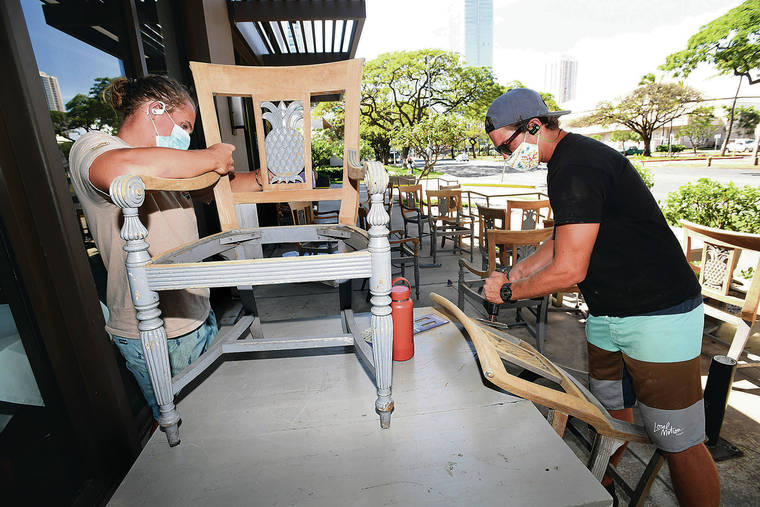
The so-called “kamaaina economy” is about to start up its engines in a significant way on Friday when Oahu eateries will be able to accept dine-in patrons again, after months that were limited to takeout and delivery meals during the pandemic stay-at-home order.
Those were only a fraction of a restaurant’s trade, so for owners who feel confident enough to ramp up staffing to operate under new coronavirus-era rules — which are extensive — they will be eager to do so. Others doubtlessly will be nervous about shouldering labor costs when prospects for revenue are so uncertain and rent must be paid.
That means customers can’t merely sit back and rejoice, in the abstract, about the return of the dine-out options for the community. Those with the money to spend should make a point of giving these local businesses the local support they deserve.
It is support that’s plainly needed, given that the recently updated and dire downward projections for state tax revenue now put the state’s budgetary shortfall at $2.3 billion.
Patronizing restaurants is a role that almost everyone can happily fill to some degree, but there will be more components that are key to the sector’s successful survival strategy.
Some of it has been supplied already. Mayor Kirk Caldwell launched a $25 million grant program using federal funds. This would provide money covering some of businesses’ costs for adapting to new social-distancing rules. Restaurants should be among the businesses applying for those.
In addition, the city is piloting an outdoor-dining provision aimed at expanding a restaurant’s usable space. This allows restaurants limited expansion space on abutting city-owned paved surfaces — sidewalks and pedestrian malls — and even adjoining parks.
This should be helpful to restaurants that can maintain health standards according to state regulations, and they should seek out these alternatives. And perhaps the city can look at other ways to extend the dine-out reach, with access to open-market events or with expanded food-truck allowances. And restaurant owners could create additional revenue streams through deliveries and catering.
Beyond those efforts, state legislators should create further grant-and-loan programs with the $636 million in federal CARES Act COVID-19 relief funds they have stashed in the state’s “rainy day” fund. This may encourage more businesses that they have a cushion to help with re-establishment of the restaurant as a going concern, even without Hawaii’s tourism traffic.
Sustaining as many eateries as possible will benefit the economy as a whole, as restaurants collectively represent a major employment center. They are important to their suppliers as well, including Hawaii’s local farming industry, and have other trickle-down effects.
As they opt to open for sit-down service, restaurants will be the leading edge of the state’s gradual reopening process. This already has welcomed back retail shops, personal-service businesses, gyms, churches, some sports and a host of other activities.
But many have not yet jumped back into anything like normal operations; some are too dependent on tourist customers and diners to make a reopening worthwhile. And they received some dispiriting news last week: Gov. David Ige confirmed that the state’s 14-day quarantine mandate for all out-of-state arrivals will extend beyond the current June 30 deadline.
There are multiple barriers to rebooting tourism. Hotel workers want firm commitments about protections before heading back to the job. It’s unclear how the pre-pandemic arrivals from the mainland U.S., tens of thousands strong, can be effectively screened. Testing capacity is an issue and whether or not Hawaii could regulate inbound passengers from other states is still unresolved.
The proposals to create an international “travel bubble” — a pact with foreign countries where travelers would bring low risk of infections, such as Japan — are intriguing. They could represent a means of transitioning back to tourism in a way that is manageable, given current limitations.
But even that limited resumption is a ways off; bookings do not yield passengers on our shores overnight. The onus for supporting restaurants and other retail operations in the interim rests with Hawaii residents themselves.
Hawaii residents who have been critical of the tourism industry and the often overwhelming numbers of visitors have been openly pleased with the current hiatus. Local people should have this opportunity to enjoy island life, they say. And they can do so fairly safely, because of the state’s low rate of coronavirus infections.
But that privilege comes with responsibility. While Hawaii remains “on break” from tourism, its residents must do their part to support their local businesses.
If finances allow, indulge in some retail therapy. And make a restaurant reservation, when that opportunity starts on Friday. Restaurants are part of the joy of community life, but they won’t survive without their neighbors’ help.
"Give" - Google News
May 31, 2020 at 05:05PM
https://ift.tt/2Ubpmhx
Editorial: Give Hawaii restaurants dine-in support - Honolulu Star-Advertiser
"Give" - Google News
https://ift.tt/2YqGX80
https://ift.tt/2YquBwx
Bagikan Berita Ini














0 Response to "Editorial: Give Hawaii restaurants dine-in support - Honolulu Star-Advertiser"
Post a Comment